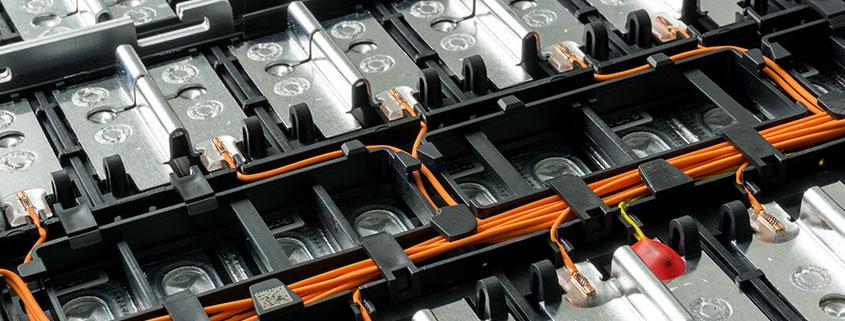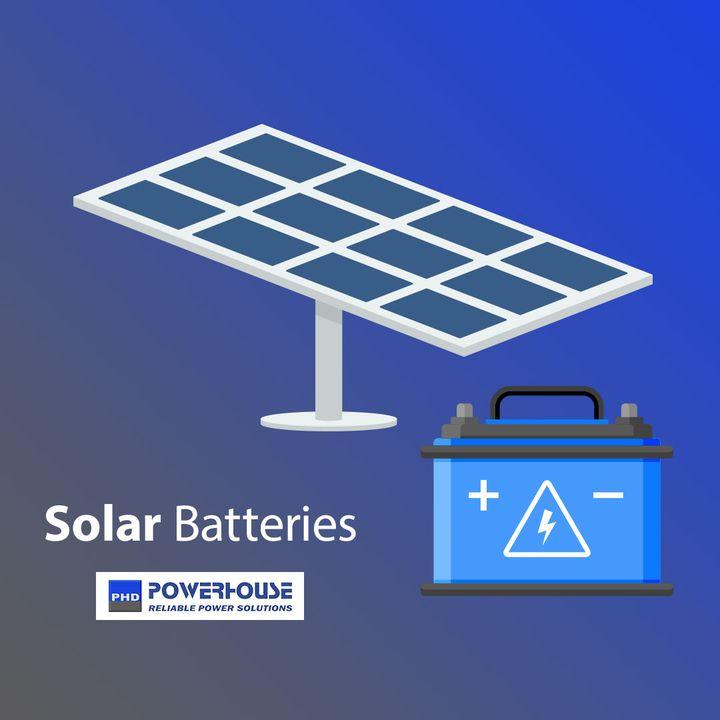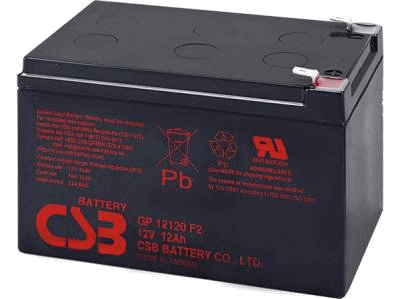Deep cycle batteries are designed to give you stable power output for an extended time. Here’s how to make the most of this amazing battery in South Africa.
What is a deep cycle battery?
A deep cycle battery is a type of rechargeable battery specifically designed to provide a consistent and steady amount of power over an extended period of time. Making it well-suited for solar power applications. Unlike standard car batteries, which are designed for short bursts of high-energy output to start a vehicle, deep cycle batteries are optimized to deliver a more constant flow of electricity for longer durations.
In the context of solar power systems, deep cycle batteries are often used to store the electricity generated by solar panels during the day for later use, such as during the night or on cloudy days when solar panel output is reduced. These batteries are an essential component of off-grid and grid-tied solar systems with battery backup.
Key characteristics of deep cycle batteries for solar power systems include:
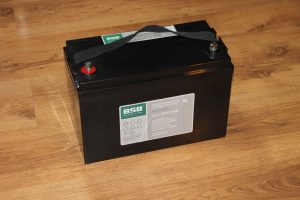
1 Durability:
Deep cycle batteries are constructed to withstand frequent charge and discharge cycles, making them highly durable and long-lasting.
2 Capacity:
They come in various capacities (measured in ampere-hours or Ah) to suit different energy storage needs, from small-scale residential systems to large commercial installations.
3 Slow Discharge:
Deep cycle batteries discharge electricity at a slower rate, ensuring a stable and continuous power supply over a more extended period.
4 Maintenance:
They are typically designed for maintenance-free or low-maintenance operation, reducing the need for frequent checking and topping up of electrolyte.
5 Chemistry:
Deep cycle batteries may use different chemistries, including lead-acid (such as flooded lead-acid batteries), sealed lead-acid (such as gel and AGM batteries), and newer technologies like lithium-ion batteries. Each type has its advantages and considerations.
6 Compatibility:
They are compatible with solar charge controllers and inverters commonly used in solar power systems.
7 Depth of Discharge (DoD):
Deep cycle batteries can be discharged to a greater depth (typically between 50% to 80% DoD) without significantly impacting their lifespan, making them suitable for renewable energy storage.
When considering the advantages of deep cycle battery for a solar power system, it’s essential to choose the correct battery. The battery needs to match the specific requirements of your system. Taking into account factors like the size of your solar array and energy consumption patterns. They also need to cater for the expected duration of backup power needed. Additionally, proper maintenance, monitoring, and sizing are crucial. This will maximize the lifespan and efficiency of deep cycle batteries in solar applications.
What are the advantages of a deep cycle battery?
Deep cycle batteries and lithium-ion batteries each have their own advantages and disadvantages. The choice between them depends on your specific application and requirements. Here are some advantages of a deep cycle battery compared to lithium-ion batteries:
1 Cost-Effectiveness
Deep cycle batteries, particularly lead-acid variants like flooded or AGM batteries, are generally more cost-effective than lithium-ion batteries. This can be especially important for those on a budget or in applications where cost is a significant factor.
2 Proven Technology
Deep cycle batteries, especially flooded lead-acid batteries, have been in use for decades and have a well-established track record for reliability and performance. Users can trust their durability in various applications.
3 Readily Available
Deep cycle batteries are widely available, making it easier to find replacements or additional batteries if needed. They are also easier to source in remote or less developed areas.
4 Tolerance to Deep Discharge
Deep cycle batteries are designed to handle deep discharges regularly without significant damage. They can typically be discharged to around 50-80% of their capacity without harming their longevity. Lithium-ion batteries are more sensitive to deep discharges.
5 Low Self-Discharge
Deep cycle batteries generally have a lower self-discharge rate compared to lithium-ion batteries. This means they can hold their charge for longer periods when not in use.
6 Maintenance
Some types of deep cycle batteries, like sealed AGM or gel batteries, require minimal maintenance or are maintenance-free. Lithium-ion batteries do not require maintenance but can be sensitive to overcharging or undercharging.
7 Safety
Deep cycle batteries are considered safer in terms of fire risk and thermal runaway compared to certain types of lithium-ion batteries, particularly when subjected to harsh conditions or abuse.
8 Recyclability
Lead-acid batteries, when properly recycled, have a relatively high recyclability rate, making them more environmentally friendly in that regard compared to lithium-ion batteries.
However, it’s important to note that lithium-ion batteries also have their advantages, including higher energy density, lighter weight, longer cycle life (if managed well), and faster charging capabilities. They are often preferred in applications where space, weight, or fast charge and discharge cycles are critical, such as in electric vehicles and portable electronic devices.
Ultimately, the choice between deep cycle batteries and lithium-ion batteries depends on various factors. These include specific application, budget, space constraints, and desired performance characteristics. It’s essential to carefully evaluate your needs and consider the advantages of a deep cycle lead acid battery and disadvantages of lithium ion batteries before making a decision.
Types of Deep Cycle Batteries
We have just discussed the advantages of a deep cycle battery, lets look at the different types of batteries. Deep cycle batteries are designed to provide a steady and consistent amount of power over an extended period of time, making them suitable for applications such as marine, RVs, renewable energy systems, and backup power. There are several types of deep cycle batteries, each with its own characteristics. Here are some common types that you need to look out for:
1 Flooded Lead-Acid Batteries (FLA):
-
- These are the most traditional and widely used deep cycle batteries.
- They use a liquid electrolyte (a mixture of water and sulfuric acid) and are known for their durability.
- Require regular maintenance, including checking and topping off the electrolyte levels and cleaning the terminals.
2 Absorbent Glass Mat (AGM) Batteries:
-
- AGM batteries use a fiberglass mat to absorb and hold the electrolyte, making them maintenance-free.
- They are known for their high discharge and charge rates and are suitable for a wide range of applications.
- AGM batteries are also spill-proof and can be mounted in various positions.
3 Gel Batteries
-
- Gel batteries use a gelified electrolyte that immobilizes the acid, making them maintenance-free and resistant to vibration.
- They are less prone to spilling and are often used in deep cycle applications where AGM batteries might not be the best fit.
4 Lithium-Ion Batteries
-
- Lithium-ion deep cycle batteries offer several advantages, including lightweight design, high energy density, and longer cycle life compared to lead-acid batteries.
- They are commonly used in high-end RVs, solar power systems, and electric vehicles.
- Lithium-ion batteries may be more expensive upfront but can provide better performance and longevity.
5 Nickel-Iron (NiFe) Batteries
-
- NiFe batteries have been around for a long time and are known for their long cycle life, often lasting decades.
- They are relatively resistant to overcharging and deep discharging.
- However, they have lower energy density and efficiency compared to some other types.
6 Lithium Iron Phosphate (LiFePO4) Batteries
-
- LiFePO4 batteries are a specific type of lithium-ion battery designed for deep cycle applications.
- They offer a good balance between performance, safety, and cycle life.
- LiFePO4 batteries are known for their thermal stability and long cycle life.
7 Saltwater Batteries
-
- These batteries use a saltwater electrolyte and are considered environmentally friendly and non-toxic.
- They have a moderate energy density and are suitable for renewable energy storage.
8 Flow Batteries
-
- Flow batteries use two separate electrolyte tanks and can store large amounts of energy for long durations.
- They are often used in grid-scale energy storage and remote renewable energy systems.
Choosing the right deep cycle battery depends on your specific application, budget, and performance requirements. Each type of battery has its own advantages and disadvantages, so it’s important to consider these factors when making a selection.
Deep Cycle Battery vs Lithium Ion Battery
Find below a comparison table between deep cycle lead acid batteries and lithium batteries. The advantages of the deep cycle battery is based on application. Lithium ion batteries have a lot more features than lead acid batteries.
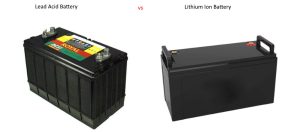
| Deep Cycle Batteries | Lithium-Ion Batteries | |
| Chemistry | Deep cycle batteries are typically lead-acid batteries, including flooded lead-acid, gel, and AGM (Absorbent Glass Mat) variants. They use a chemical reaction involving lead and sulfuric acid to store and release energy. | Lithium-ion batteries use lithium as one of their primary components and rely on lithium-ion movement between the positive and negative electrodes to store and release energy. There are various lithium-ion chemistries, including lithium iron phosphate (LiFePO4), lithium cobalt oxide (LiCoO2), and more. |
| Energy Density | Deep cycle batteries typically have lower energy density compared to lithium-ion batteries. This means they are heavier and bulkier for a given energy storage capacity. | Lithium-ion batteries offer higher energy density, making them lighter and more compact for the same amount of energy storage. |
| Weight | Deep cycle batteries are heavier, which can be a consideration for mobile or portable applications. | Lithium-ion batteries are significantly lighter, making them ideal for portable devices and electric vehicles. |
| Cycle Life | Deep cycle lead-acid batteries typically offer a lower cycle life compared to lithium-ion batteries. They may last around 300 to 700 charge-discharge cycles, depending on the depth of discharge and maintenance. | Lithium-ion batteries generally have a longer cycle life, often exceeding 1,000 cycles and potentially reaching 2,000 cycles or more, depending on the specific chemistry and usage conditions. |
| Depth of Discharge (DoD) | Deep cycle batteries can tolerate deeper discharges (50-80% DoD) without significant negative effects on their lifespan. | Lithium-ion batteries are sensitive to deep discharges, and deep cycling can reduce their lifespan. Typically, it’s recommended to stay within a 20-80% DoD range for optimal longevity. |
| Maintenance | Some deep cycle batteries, like flooded lead-acid, require regular maintenance, including topping up with distilled water and cleaning of terminals. | Lithium-ion batteries are typically maintenance-free. |
| Charging and Discharging Efficiency | Deep cycle batteries have lower charging and discharging efficiency compared to lithium-ion batteries. They may lose more energy as heat during these processes. | Lithium-ion batteries are more efficient, with higher charge and discharge efficiency, meaning less energy is wasted. |
| Cost | Deep cycle lead-acid batteries are generally more cost-effective upfront but may require more frequent replacements over time. | Lithium-ion batteries have a higher initial cost but can offer better long-term value due to their longer lifespan and efficiency. |
| Environmental Impact | Lead-acid batteries have environmental concerns due to lead and sulfuric acid content. Proper recycling and disposal are essential. | Lithium-ion batteries are considered more environmentally friendly due to their lower toxicity, longer lifespan, and recyclability. |
How does it work?
Solar deep cycle batteries, unlike starting batteries often found in vehicles and sealed lead acid batteries, have thicker lead plates and are designed for long, slow discharges, making them ideal for storing and supplying energy in off-grid and backup power systems. The design of deep cycle batteries is adapted to withstand repeated charging and discharging cycles. They use denser active material and thicker battery plates. Thicker plates help the battery life last longer.
These plates are also solid lead instead of sponge, giving less surface area. This means less instant power such as that in a starter battery, but also allows this battery to discharge 80% of its power over and over. Even though they can discharge up to 100% of their power, manufacturers often recommend that the charge level not be dropped below 45% on a regular basis.
What are the uses of this type of battery?
Because these batteries are lightweight, quick to charge, and long-lasting, they’re ideal for a wide range of uses. Lithium-ion technology is often used in marine applications, such as watercraft. Deep cycle applications are vast because they give users sustained energy levels.
One of the biggest and most popular applications is to use deep cycle batteries for solar power storage. They act as a large solar battery bank, storing the energy you collect via solar panels but do not use. Then, on a rainy day, you can use the power in this battery to power your home.
People use these batteries in recreational vehicles, golf cars, forklifts, and other commercial applications, too. They can handle many discharge cycles and the rate of discharge is stable enough to rely on for long periods. This is ideal for solar systems and backup power systems.
Explore our deep cycle solar battery options today to find the ideal solution for your off-grid power system.
How to charge a deep cycle battery?
The way you charge it makes a major difference to the battery life. While lead-acid batteries need to be charged in multiple sessions to reach their full capacity, lithium-ion batteries can be fully charged in just one session.
A dead battery is never good, because it means it has lost all its charge. The chemical reaction inside can result in reduced battery capacity. When using a battery that is frequently completely discharged, you may notice it does not reach its original capacity. For this reason, you should aim to charge the battery fully whenever the need arises.
How to extend the life of a deep cycle battery?
Proper charging plays a big role in extending your battery’s life. Regular maintenance is also important. Its important to build on the advantages of the deep cycle battery. You can enjoy continuous power for longer by applying the below steps.
1. Avoid opportunity charging.
“Opportunity charging” means plugging the battery in whenever you feel like it for bursts of time throughout the day but not letting it charge fully. Instead of charging the battery here and there whenever you get a chance, you can extend its life by giving it a change to charge in a full cycle every day.
This conditions the battery, preventing sulfation damage to the plates. A battery that is properly conditioned holds its charge better, and the battery life does not deteriorate as fast. Preserve the cycle life of your battery by avoiding opportunity charging.
2. Know when it needs to charge.
You can protect your battery by learning about its depth of discharge specs. If you discharge it to 80% of its capacity, but always recharge it to 100%, you can generally expect to get 220 complete cycles of use out of it. If, however, you only discharge it to 50% each time before charging it, you could get 750 complete cycles!
The thing is, constantly charging it could also damage it. One should not charge it after only 10% of the load has been discharged, for example. It’s all about charging at the right time. Not too much, and not too little. In this way, you can vastly extend your battery’s life.
3. Keep it at optimum ambient operating temperature.
Keep it in a location that is room temperature and dry. Battery temperature plays a big role in the rate of discharge and longevity of the device. Battery manufacturers suggest avoiding freezing temperatures and extreme heat. Batteries stored in extreme freezing temperatures or heat break down much faster.
4. Use the best storage & maintenance.
When you aren’t using it, it’s best to keep it fully charged. Many batteries have a slow self-discharge, but deep cycle solar batteries often only have a 2-5% discharge when not in use. Battery maintenance, in this case, means checking to see how much charge it is holding while not in use. If its self-discharge level is high, it may mean you need to replace some cells.
5. Use a slow charging method.
You can extend your battery life by charging it as slowly as possible. Charging it overnight is an excellent example, or if you use it for solar power, charging it during the day to use at night. This benefits your battery’s internal components and is preferable to only charging it for a few hours at a time. Rapid charging often increases the internal temperature, which is why you should avoid it if you want your battery to last longer.
What deep cycle battery do I need?
The type you need depends on its application. Refer to the section above that highlights the advantages of a deep cycle battery by type. You can also look at the key factor list below:
- Type. You can choose between lead-acid deep cycle batteries and AGM batteries, Gelled Electrolyte (or gelled batteries), and Flooded (or wet cell batteries).
- Size. Its physical size can influence things if you need it for applications where lightweight, small-sized batteries are ideal.
- Rate of Discharge. The rates of discharge can be significant, because larger batteries may give you longer periods of sustained power use.
- Amp-Hour Capacity or Charge Efficiency. Different size batteries give you different volumes of power or kilowatt hours. If you need more power, you may need a larger size. A 20-hour discharge when in use may be ideal for your needs if you want to use it for solar in your home.
- The Green Factor. Environmentally, lithium-ion batteries are much safer and cleaner.
- Charge Time. The time it takes to fully charge may matter, depending on what you want to use it for.
- Shelf Life. Some batteries have a longer shelf life than others because of their size, the materials they are made of, their maximum voltage, and their durability in cold temperatures (etc). Longer-lasting options are ideal for electric systems that need constant voltage and are used routinely.
Battery companies can help you find the right one for your needs. Battery life and performance are key when you want to use a deep cycle battery for solar. You can speak to us about solar battery solutions and the proper care of your battery.
Further reading: relion; mkbattery;

